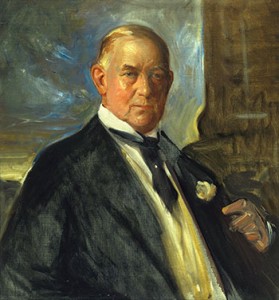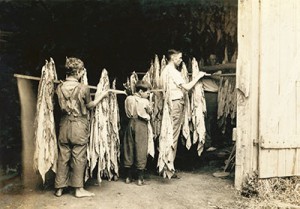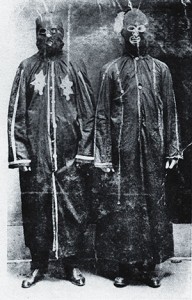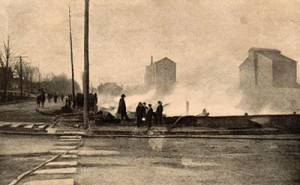On December 7, 1907, 300 to 500 men, armed and mounted in columns of two, all wearing masks and white sashes, rode into Hopkinsville, seat of Christian County, Kentucky. Advance parties disarmed the small city’s police force, occupied the Cumberland Telegraph and Home Telephone offices, and dynamited three warehouses packed with valuable fire-cured tobacco.
While the warehouses burned, the interlopers destroyed the offices of the Hopkinsville Kentuckian, the local newspaper. After beating an Imperial Tobacco Co. buyer and wounding a Louisville & Nashville Railroad brakeman who was trying to save a burning freight car, the attackers formed up at Ninth and Main, the center of town, holstered their weapons, and rode off. A posse of 11 citizens pursued; two of those townsmen died in a running gun battle. The violent times that included the Hopkinsville attack would become known as the Black Patch Wars and would enter Christian County folklore.
Hopkinsville, a tobacco shipping center served by the L&N and Illinois Southern railroads, played a prominent role in the region called the Black Patch for its main crop—a strain of tobacco cured over burning hardwood that turned the leaf black, imparting a savory flavor that chewing tobacco and snuff users prized. The rolling hills of the Patch—at its center three counties in west Tennessee and six counties in Kentucky—provided well-drained fields for growing tobacco, and forests of hickory and oak provided fuel for the curing fire.
Growers large and small—plantation owners, their sharecroppers, and smaller independent farmers—harvested and smoked the leaf they grew and brought it in bales to a locally owned warehouse. Buyers representing chewing tobacco or snuff manufacturers inspected and bid for individual lots at auction. The “dark-fire” leaf would be packed in hogsheads and stored for months, even years. Competition for the best crop was strong.

James Buchanan
Duke formed the American Tobacco Company, which tried to corner the market. (Smithsonian National Portrait Gallery)
In the 1880s, North Carolina tobacco industry scion James Buchanan Duke began buying up and consolidating smaller manufacturers into his American Tobacco Company. By the early 1900s, Duke’s giant company, in partnership with British Imperial Tobacco Company and Italian firm Regie, dominated the chewing tobacco market and squelched competition. Farmers had no choice but to bring their crop to an American Tobacco–controlled warehouse and accept the price offered, even at a loss.
The same pattern was playing out across American agriculture, as industrial consolidation created manufacturing behemoths called trusts that dictated prices for grain, meat, and other commodities. In 1890, President Benjamin Harrison signed into law the Sherman Anti-Trust Act, starting a decades-long federal fight against trusts like Duke’s.
To battle trusts, angry farmers in the Midwest and West organized the Grange, the Farmers’ Alliance, the Populist Party, and other economic self-defense organizations. In the South, the revolt took on a different character, particularly in the Black Patch, where dark-fire tobacco farmers exacted rough economic justice in a fiery campaign that began with lofty intent but descended into bloody fury before burning out.
In 1903, growers in the Black Patch had to stand helplessly as the trust cut prices for their leaf to four and even two cents a pound. During the 1904 harvesting season, facing impoverishment, planters of the local elite called a meeting in Guthrie, Kentucky, on the Tennessee border. On September 23, thousands lined up in a festive atmosphere to join the newly formed Dark Tobacco District Planters Protective Association of Kentucky and Tennessee. The association’s pitch was simple: Growers would deliver their dark-fire crop not to American Tobacco but to the association, which would hold the leaf until buyers offered at least eight cents a pound.

The association dispatched recruiters throughout the region to visit farmers in churches, stores, and schoolhouses. Big plantation owners saw the association as the only way to preserve their way of life; independent white farmers were less likely to go along because they saw collective action as infringing on individual liberty. Caught in the middle were black sharecroppers, many of them former slaves. The association didn’t invite blacks to join; it simply expected them to do as they were told.
Economic reality undercut the effort. Wealthy planters could wait out American Tobacco, and even help tenants get by, but small operators derided as “hillbillies” needed cash immediately, and Duke’s buyers were paying eight cents to defecting growers.
The association tried shaming, then shunning turncoats. A merchant who spoke against the group lost customers. Dissenting preachers watched their churches empty. The association’s public face was polite and peaceful, at least to whites, and by the movement’s peak in 1907, 70 percent of Black Patch farmers had pledged allegiance to the group.
Leaf prices began to rise, but with his deep pockets and enormous buying power, Duke was picking off growers, even association stalwarts. The planters faced the same problem as unions: How to enforce solidarity? They tried the same tactics as organized labor: First persuasion, then force. In November 1905, after growers had harvested and readied crop for sale, the association adopted resolutions that Kentuckian publisher Charles Meacham later recounted:
“We, the Farmers,…proclaim and enunciate the following truth(s): Of the infamous trusts doing business in violation of the law, the Tobacco Trust is the most greedy and oppressive in that it robs the laborer and share-cropper of a just price for his only money crop.”
The resolution denounced “in the severest terms” growers selling to American Tobacco. “We, as an association, withdraw our support from any man…who, by word or deed, lend[s] assistance to our trust enemies.” Now the nightriding would begin.
The riders belonged to a secret paramilitary group that authorities never officially could link to the planters’ association. Members called themselves the Silent Brigade and organized into county “lodges.” They took oaths, learned secret handshakes, and memorized passwords, vowing harsh penalties against anyone trading with the trust. Only David Amoss, a physician from Cobb, Kentucky, was ever identified in court as a brigade leader. Emulating the Ku Klux Klan, members wore white sashes and masks that served less to hide identities than to enable witnesses to swear they had not recognized individuals they might have seen.

As its first targets, in spring 1906, the brigade picked independent farmers trading with Duke. A grower balking at a warning would find a threatening letter signed “The night riders” nailed to a barn door. That spring, the vigilantes sabotaged noncompliant growers’ planting beds by hoeing under the tobacco seedlings or sowing the planting grounds with salt or grass seed.
Amid threats and attacks, the association campaigned for solidarity. After a series of open meetings, a second gathering took place in Guthrie on September 24, 1906. This time, 20,000 people attended an event to celebrate the farmers’ defiance of the trust. The gathering ended in a miles-long parade of planters, Confederate veterans, and belles bearing bouquets of dark leaf. Last came a rear guard of 1,000 black sharecroppers.
Despite the association’s initial success in enrolling 70 percent of Patch growers, the only way for the association to beat the trust was to get 100 percent loyalty, and the only way to do that was through intimidation. Disavowing any connection to the nightriders, the association nonetheless expressed sympathy for their goals. The atmosphere became hotter, and lodges began conducting armed, military-style drills.
On December 1, 1906, Princeton, Tennessee, 28 miles south of Hopkinsville, woke to the muffled steps of 200 horses, hooves wrapped in burlap. Callers trying to reach the local telephone switchboard heard a gruff male voice say, “The nightriders are here.” A blast rocked the town and two tobacco warehouses went up in flames, destroying 75 tons of nonassociation leaf.
The next attack would aim higher.
In his newspaper, Meacham, who also served as Hopkinsville’s mayor, had editorialized against the nightriders. Fearing they would come for his town next, he placed the local company of the Kentucky State Guard on alert.
The militiamen had a long wait. The nightriders used feints and disinformation to confuse townspeople and troops, sending squads to infiltrate the town but not attacking. An uneasy standoff persisted until Friday, December 7, 1907, when that double column of masked men sporting white sashes bore down on Hopkinsville. Embedded squads went into action, disarming the militia and the police and politely taking female Home Telephone Company operators into custody. Raiders cut the telegraph lines and occupied the railroad depots, rounding up the few people on the streets.
According to Meacham, the riders torched three tobacco warehouses. Flames lit the skies, and the vigilantes wrecked the Kentuckian office. Raiders shot and wounded a railroad worker. After 30 minutes of mayhem, the riders released their hostages with grave warnings and withdrew. Amoss, bleeding from a minor head wound, led the riders out of town, chased by a posse.

On January 3, nightriders burned two warehouses in Russellville, Kentucky, owned by Luckett-Wake and the American Snuff Company.
As spring 1907 approached, the brigade ruled the Patch, invulnerable to local law enforcement and unlikely to face interference from the federal troops of trust-busting President Theodore Roosevelt, who empathized with farmers and hesitated to intervene in local matters. In the Patch, riders struck in small bands, burning barns, destroying plant beds, horsewhipping farmers, and vanishing.
Nightrider attacks were not always about tobacco prices and maintaining an agrarian way of life. Much of the worst Patch violence was inflicted upon African-Americans, to terrorize them into line with association policy, drive them away so whites could work the land that they had sharecropped or owned, or simply to act on racist hatred.
On March 9, 1908, nightriders mounted a Klan-style raid on Birmingham, Kentucky, a small town that freed slaves had built between the Cumberland and Tennessee rivers; residents who did not flee were slain.
As raids became bloodier, defiance flared. Independent growers took to guarding their fields at night and tried to ambush brigade riders. Assassination attempts sent Amoss underground; he led his forces from hiding.
The brigade fought back. When a Dycusburg, Kentucky, tobacco buyer and businessman taunted the association, riders burned his barns, destroyed his distillery, and brutally whipped him. Lodge members thought to be wavering disappeared, their corpses later found in bogs or wells—or not at all.
Pressure for action rose outside the Patch. The Louisville Courier-Journal denounced the nightriders as the shame of Kentucky and called for law and order.
Newly installed Kentucky Governor Augustus Willson ordered several companies of the State Guard into the Patch to set roadblocks and conduct patrols that constrained the riders. But that also increased the outlaws’ popularity: Locals saw the militiamen, mostly mountaineers from the state’s east, as an occupying force. Arrests made no difference. The only people who went to jail were those who fought the riders.
Some survivors fled to Ohio River towns such as Metropolis, Illinois, and Evansville, Indiana. From that safe distance, victims filed civil suits against wealthy landowners thought to lead the vigilantes. Because they were interstate legal actions, these suits became federal cases, with acquittal by friendly jurors no longer a given. Lodges had to raise funds to pay off judgments against their captains.
The war in the Black Patch waned at the end of 1908, though acts of terror continued. Auctions resumed, and leaf prices began to rise. Planters Association membership fell from 70 percent of Black Patch growers to less than 50 percent. The riders faded away, put out of business by eight-cent tobacco and their own excesses.
In 1911, Commonwealth Attorney Denny P. Smith of Cadiz, Kentucky, and a team of local prosecuting attorneys obtained indictments for “conspiracy and destruction of property” against Amoss and Guy Dunning, a planter accused of being Amoss’s second in command. The trial, in Hopkinsville, began on March 6. Amoss’s backers crowded the courtroom for the 10-day trial. So did the raiders’ victims.
The prosecution had recruited witnesses by offering immunity. Former nightriders testified not only about the Hopkinsville raid but also about brigade rituals and procedures. Yes, Amoss was the general, Dunning his lieutenant. Fingers pointed at maps, exposing secret meeting places. Voices recited the nocturnal oaths.
Amoss presented an unadorned defense. He was a simple country doctor, out delivering a child or binding a wound at those times accusers claimed he had been commanding nightriders.
Not only the Courier-Journal but the Atlanta Constitution and the New York Times sent reporters to Hopkinsville. The courtroom was silent as the jury returned with a verdict after 40 minutes of deliberation: Not guilty on all counts.
Two months later, in May 1911, the U.S. Supreme Court ruled the American Tobacco Company an illegal conspiracy under the Sherman Act. Duke had to break up his empire—but into parts he still controlled.
The 20th century was hard on the Patch. Cigarettes made with lighter burley tobacco became popular, especially among men who served in World War I, sapping dark-fire chaw profits. Growers tried repeatedly to hold back leaf to boost prices, but tobacco companies—still big, still powerful—usually had thousands of hogsheads warehoused to cover any shortfall. The New Deal brought federal subsidies for commodities, including tobacco, that lasted until the 1990s. The demise of subsidies drove out many small growers. Now Patch tobacco is grown on a large scale, with landowners contracting with manufacturers; however, workers process the leaf the old-fashioned way, curing it over a low-burning hardwood fire in sealed barns.
Today, dark-fire tobacco’s stronger flavor enhances smokeless products, including chewing and dipping tobacco, moist and dry snuff, and a Swedish product called snus. Cigarette smoking continues to decline, but smokeless tobacco product sales have risen.
For decades, old-timers declined to discuss the nightriders, fearing retribution or remaining loyal to oaths taken under a harvest moon. Now, however, schoolchildren in Christian and other counties in the Patch learn about the nightriders who fought the hated trust. Some communities re-enact the Black Patch Wars in annual events. And at the end of the 2015 season, dark-leaf fire-cured tobacco, grown and processed using methods that would have been familiar to Patch residents of a century ago, brought about $2.70 a pound. ✯
This story was originally published in the September/October 2016 issue of American History magazine. Subscribe here.





